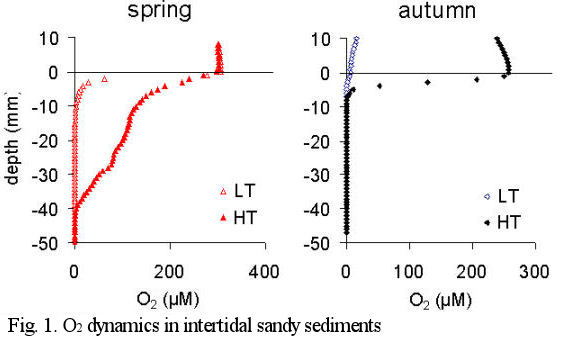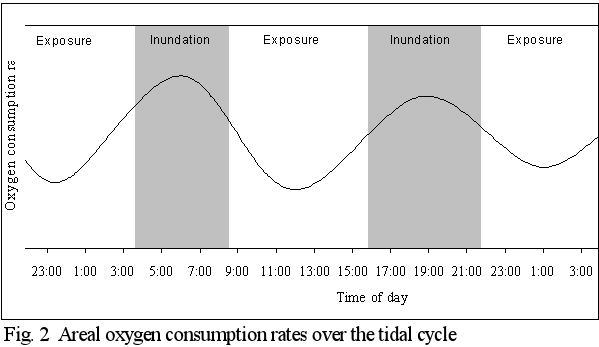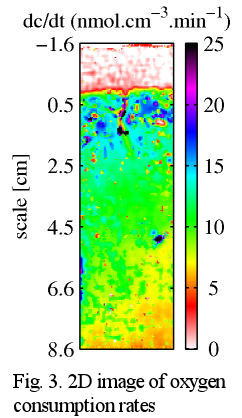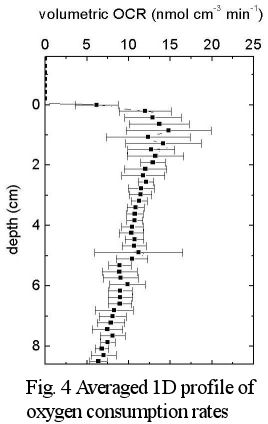
BioGeoChemistry of Tidal Flats
Transport and mineralization in intertidal sediments
Microbial conversion rates and transport phenomena in intertidal sediments were measured with a combination of in situ microsensor and laboratory incubation techniques. Intertidal areas are subjected to highly variable conditions. Interfacial and internal transport is determined by the hydrodynamics (tides, waves, and currents), conversions by varying temperatures, light (photosynthesis) and organic input. In permeable sediments advective processes lead to an enhanced exchange of particles and solutes with the overlying water. The availability of e-donors and e-acceptors such as oxygen and organic material is therefore highly fluctuating in time and with sediment depth. Porous sediments can be compared to biofilters, which efficiently remove and turn over particles and solutes from the water body.
Measurements were performed during tidal cycles in different seasons by using microsensors attached to an autonomous in-situ measuring device (PROFILUR), on two locations, a sandy and a mixed flat in the backbarrier area of Spiekeroog. Recorded parameters are O2, H2S, pH and T. Oxygen consumption rates (OCR) were determined on intact sediment cores, by perfusing the cores with oxygenated seawater and following locally the initial oxygen consumption rate, either by microsensors or by planar optodes. By integrating the acquired potential OCR over the depths of oxygen penetration (measured with PROFILUR), areal OCR were obtained. Sulfate reduction rates were measured by radiotracer incubations. On the permeable sand flat, oxygen penetration was highly variable and fluctuating with time, with the deepest penetration during inundation (Fig.1). Oxygen penetration reached its maximum in winter. During summer the penetration depth was reduced due to higher sedimentary oxygen demand.
Increased transport of O2 into the sediments at high tide increased microbial respiration rates considerably. This is demonstrated in Fig. 2, showing the trend of oxygen consumption rates at different stages of the tidal cycle.
In the area near the low water line, smelly black anoxic surface sediments develop during low water, independent of the season. These seeps are the result of local drainage of anoxic pore water from the plate. Microsensor measurements performed in the seep areas demonstrated a very strong tidal influence at this site. During low tide oxygen disappeared from the overlying water of the sediments (Fig. 1, autumn), H2S and nutrients in high concentrations are released into the overlying water. Also gaseous methane release was observed. The black surface sediments at the lower edges of the plates seem to be exchange channels, connecting the anoxic and the oxic world. They may play an important role for the carbon and nutrient cycles in intertidal ecosystems.


Flow-through method
We developed a method for the measurement of potential volumetric oxygen consumption rates (OCR) in permeable sediments with high (0.3-1mm) spatial resolution (Polerecky et al., submitted to L&O: Methods). The method is based on percolating undisturbed sediment collected by a core with aerated water and monitoring the decrease of oxygen in the sediment after the percolation is stopped.
The oxygen measurements are done either with micro-electrodes or planar optodes, resulting in a one-dimensional or two-dimensional profiles of OCR (Fig.3). When the OCR images obtained by planar optodes are averaged in the horizontal direction, 1D depth profiles of OCR are obtained (Fig.4).
This method provides a better insight into the sediment, as it enables the assessment of the functional variability of the processes governing the oxygen uptake on a submillimeter scale. For example, the method allows to differentiate between the microbial activity and bioturbation or bioirrigation, which is not possible using the commonly used benthic-chamber method or the newly developed eddy-correlation technique.
By combining the high-spatial-resolution vertical profiles of OCR with the high-spatial-resolution oxygen profile, one can evaluate the areal oxygen consumption rate of the sediment. Since the oxygen profiles are measured in situ and over long time intervals (typically 2-4 tidal cycles), it is possible to assess the temporal variability of the total oxygen uptake by the sediment.


| <<back | All publications
|